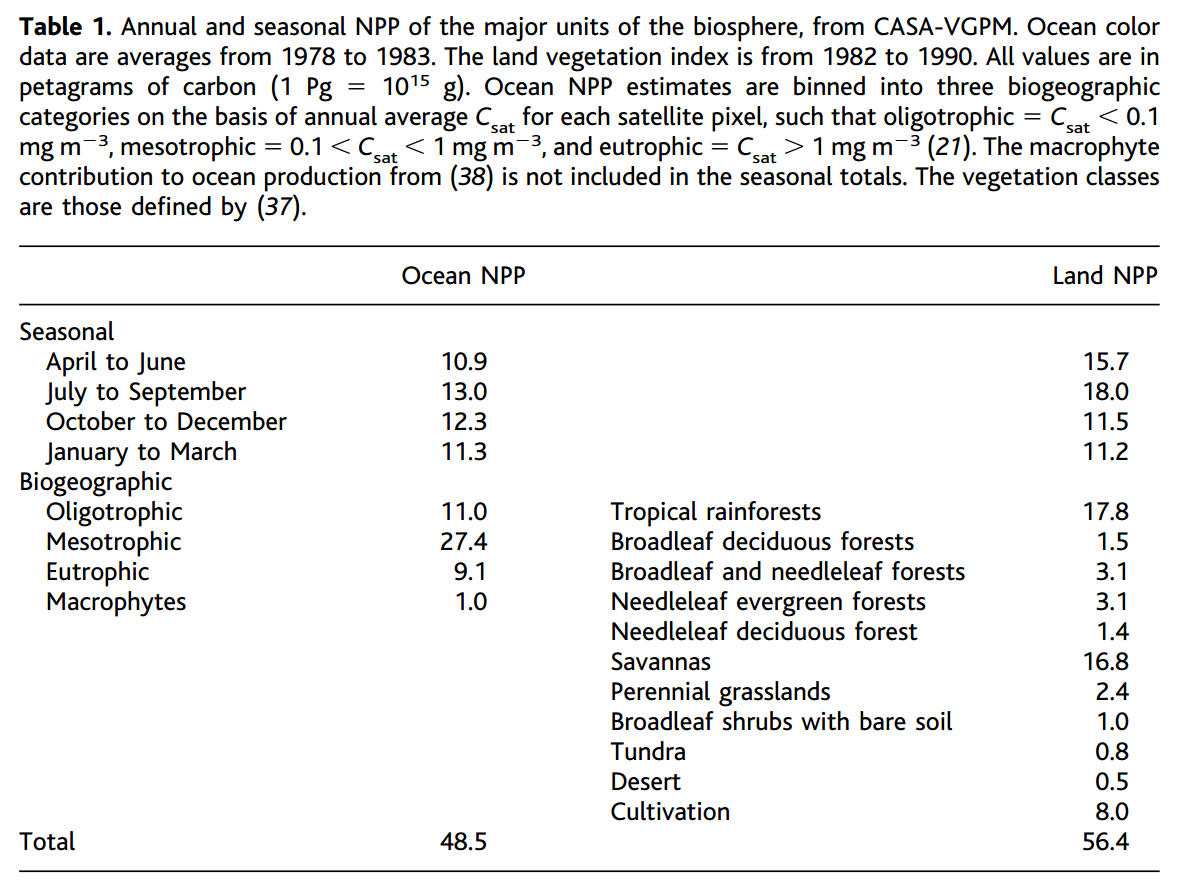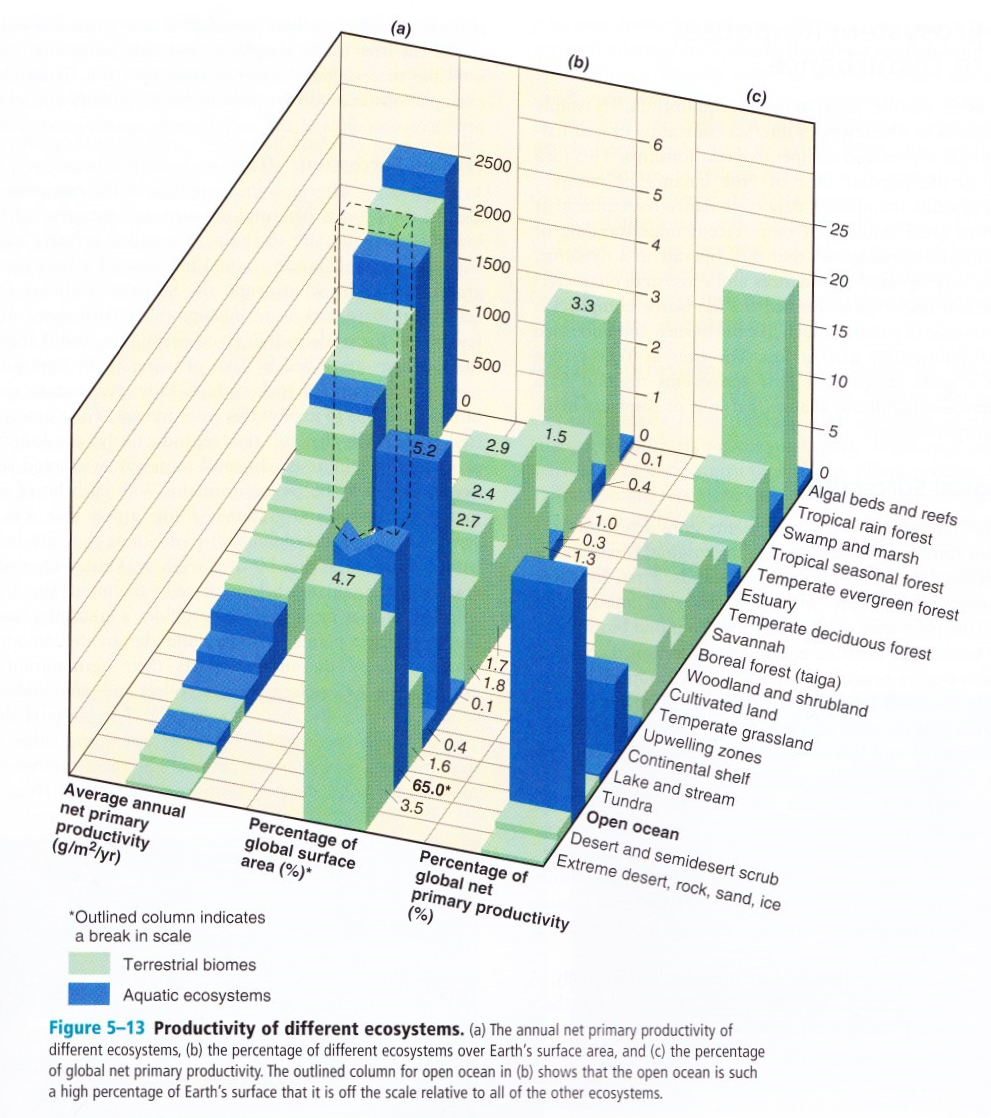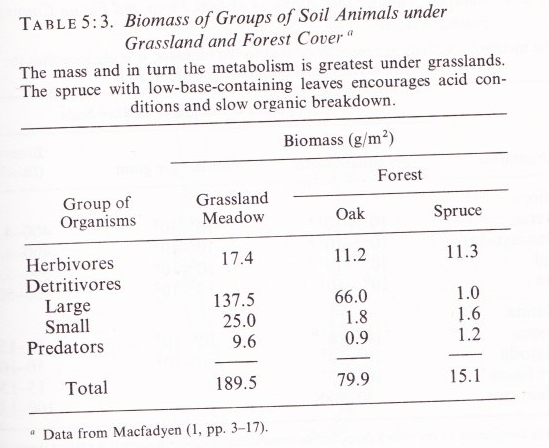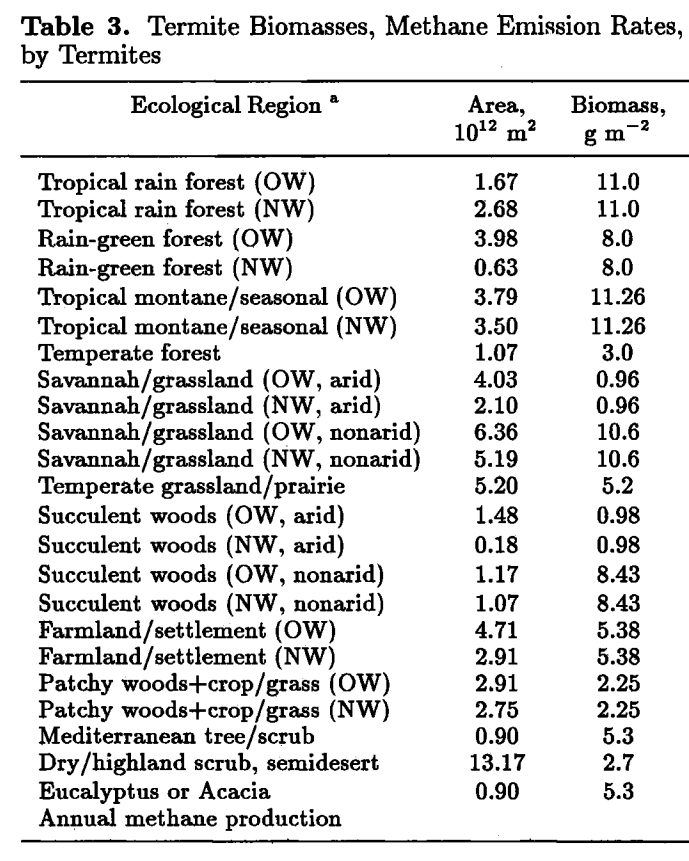Summary
This piece compiles and comments on different estimates of how net primary productivity (NPP) varies by land type. This is useful because NPP is a reasonable proxy for the total suffering in an ecosystem.
Contents
Epigraphs
If you're afraid of illnesses, if you are afraid of death, then you should contemplate where they come from. Where do they come from? They arise from birth. [...] If you want to be sad, be sad when people [or animals] are born: "Oh, no, they've come again. They're going to suffer and die again!"
NPP is the ultimate source of energy for all organisms in an ecosystem, and thus determines the amount of energy available to support that ecosystem.
--Ecology by Cain, Bowman, and Hacker
More plants meant more bugs, frogs, fish, snakes and birds that fed on them all.
Why NPP?
NPP is the amount of useable energy available for heterotrophs in the food web. This is basically an energy "budget" that gets "spent" on the respiration of various organisms until all the energy runs out. Most energy is spent immediately by an organism, while some goes into "savings" in the form of body weight or offspring. Those savings are then "stolen" by predators / parasites or "inherited" by decomposers.
The total amount of heterotrophic respiration is basically proportional to NPP (when measured in Joules, not kilograms, per unit area per year), except when NPP is destroyed by abiotic processes like fire or is trapped in a form that's hard for non-human organisms to use, such as fossil fuel.a And if we assume "that total efficiency of energy utilization is independent of body size", then the amount of "biological work" an organism does should be roughly proportional to respiration.
Suppose we care mainly about brain metabolism, not total body metabolism, since brain activity is more relevant to sentience than non-brain body activity. It turns out that, with some exceptions, "healthy adults of most vertebrate species use 2-8% of their basal metabolism for the central nervous system" (Mink, Blumenschine, and Adams 1981). (I haven't looked into the details of this finding, nor whether it applies to invertebrates.) So to a very rough approximation, brain metabolism is proportional to total body metabolism.
If we attribute sentience to organisms roughly in proportion to their metabolic rates, then the total amount of heterotroph sentience in the world will be roughly proportional to the world's NPP. In practice, perhaps we'd care less about a mushroom and more about insects that could be powered by the same amount of energy as the mushroom is consuming. But in general, using NPP as a proxy for total sentience seems reasonable to a first approximation.
If we ignore differences in quality of life among organisms, then total suffering should be roughly proportional to total sentience. Big animals may have much better qualities of life than insects and bacteria, but big animals also have much less biomass than insects or bacteria, so the approximation of suffering as roughly proportional to sentience may hold reasonably well for most organisms that exist.
I think it's often more important to focus on changing plant populations than changing animal populations directly, because plants are the bottom of the food chain and the "roots" of the problem of wild-organism suffering. If plant food is created, then (except in cases of fire, fossil fuels, etc.) some organism will eventually eat that food, which will increase heterotroph populations. Of course, for some species, the growth-limiting factor is something else besides food (e.g., water, climate, space, predators keeping down prey numbers). But for heterotrophs as a whole, it seems like food is overwhelmingly the growth-limiting factor in the long run, since otherwise, we would see ecosystems where vegetation just keeps accumulating, with no one eating it (at least until the vegetation got so dense that plants could no longer grow there). But we don't often see that. Even in eutrophic lakes, bacteria and other microscopic organisms eventually eat the burgeoning plant matter.
Based on the above discussion, and using some very rough approximations, we could say the following, where the symbol ∝ means "is proportional to":
total animal suffering ∝ total animal sentience ∝ total animal brain metabolism ∝ total animal body metabolism = food eaten by animals in an ecosystem ∝ ecosystem NPP.
The last proportionality assumes that a roughly constant fraction of an ecosystem's NPP is eaten by animals rather than by bacteria/fungi/etc.
If we also care about non-animal heterotrophs, we could say
total heterotroph suffering ∝ total heterotroph sentience ∝ total heterotroph metabolism = food eaten by heterotrophs in an ecosystem ≈ ecosystem NPP.
The approximate equality (the ≈ symbol) in the above equation is because some fraction of NPP may be burned or stored for very long periods without decomposing.
In a paper whose conclusion I disagree with, Nick Bostrom says:
The utilitarian imperative “Maximize expected aggregate utility!” can be simplified to the maxim “Minimize existential risk!”.
In analogy, we might say roughly that
The negative-utilitarian imperative “Minimize (biological) suffering!” can be simplified to the maxim “Minimize NPP!”.
![Brian Tomasik created this image by combining the following input images: (1) '… idk. Cause I felt like it. NADP+ wasn't invited.' By Kelvinsong (Own work) [CC0], via Wikimedia Commons: https://commons.wikimedia.org/wiki/File:I_can_photosynthesis.svg (2) 'Yellow dead insect on a trail between Tignes and Tignes 1800, France.' Tiia Monto [CC BY-SA 3.0 (http://creativecommons.org/licenses/by-sa/3.0)], via Wikimedia Commons: https://commons.wikimedia.org/wiki/File:Dead_yellow_insect.jpg (3) 'Parasteatoda tepidariorum and Cicadella viridis.' By Luis Miguel Bugallo Sánchez [GFDL (http://www.gnu.org/copyleft/fdl.html) or CC BY-SA 4.0-3.0-2.5-2.0-1.0 (http://creativecommons.org/licenses/by-sa/4.0-3.0-2.5-2.0-1.0)], via Wikimedia Commons: https://commons.wikimedia.org/wiki/File:Ficheiro-Ara%C3%B1a_aliment%C3%A1ndose_de_Auchenorrhyncha._Bastavales,_Bri%C3%B3n,_090905.jpg (4) 'Heterodon platirhinos playing dead.' By Benny Mazur from Toledo, OH (Hognose snake playing dead Uploaded by berichard) [CC BY 2.0 (http://creativecommons.org/licenses/by/2.0)], via Wikimedia Commons: https://commons.wikimedia.org/wiki/File:Heterodon_platirhinos_2.jpg](/wp-content/uploads/2016/04/NPP_and_suffering.png)
Minimizing NPP is much simpler as a strategy than trying to analyze the complete causal impacts of changing a food web at a higher level than primary production. Real food webs are extremely complex (e.g., see Figure 3 here), and changing one node in a food web can have many ripple effects that are hard to calculate. In contrast, NPP is an aggregate measure that abstracts away the complexity of the food web. As an analogy, suppose I give a total of $1 million to a group of 2000 people in an isolated economy. Those people will proceed to buy and sell goods, give gifts, steal from one another, and so on. Modeling who ends up with how much money via what transactions is extremely complicated. But regardless of those details, I know that the economy contains a total of $1 million.
Ecologists are correct when they warn those who want to reduce wild-animal suffering about the immense complexity of ecosystems. It is indeed very difficult to say how a given intervention (say, vaccinating wild mammals against diseases) will affect overall suffering in an ecosystem. However, ironically, this complexity is a reason in favor of reducing NPP (such as via land-use change) rather than trying to tweak existing ecosystems. It's extremely hard to say how a given intervention to help wild animals will affect other parts of the system (especially if you care somewhat about invertebrates). It's much easier to say that some types of land cover give rise to fewer total (sentience-weighted) animals than other types do.
Insofar as we care to some degree about plants, perhaps we'd want to focus on gross primary productivity (GPP) rather than NPP, but I assume GPP and NPP are pretty closely correlated. And I may care less about plants per unit of energy expended than I care about other organisms.
I encourage those working on issues of wild-animal suffering to consider NPP as perhaps the foremost metric when evaluating policies. NPP is a relatively simple measure of what would otherwise be a hopelessly complex collection of considerations based on detailed interactions among tens or hundreds of species in a food web.
Of course, if you don't care at all about unicellular organisms, or if you weigh animals very differently than proportional to their metabolic rates, then total NPP may be an unsatisfactory approximation of moral disvalue, and you might prefer to focus on the portion of NPP eaten by (particular kinds of) animals.
NPP per unit area
Jackson and Jackson (2000)
This textbook reports the following numbersb:
| Land type | Average NPP (tons per km2 per year) |
| Algal beds and reefs | 2500 |
| Tropical rainforest | 2200 |
| Swamp and marsh | 2000 |
| Estuaries | 1500 |
| Temperate deciduous forest | 1200 |
| Boreal forest | 800 |
| Cultivated land | 650 |
| Temperate grassland | 600 |
| Continental shelf | 360 |
| Tundra and alpine | 140 |
| Open ocean | 125 |
| Desert and semi-desert | 90 |
What does this tell us about the impact of crop cultivation on NPP? If crops replace forests, these numbers suggest a decrease in NPP, while if crops replace grassland, there may be no big change or a slight increase in NPP. (This analysis ignores the difference between correlation and causation: A lot of the variation in NPP may be inherent to an area, and NPP only changes so much when land use changes.)
Other
Fig. 1 on this page gives numbers with the same general trend but somewhat lower absolute values as in the Jackson and Jackson (2000) table. I see that the linked web page defines NPP in terms of mass of carbon, while perhaps Jackson and Jackson (2000) reported NPP in terms of total dry mass? If so, that would explain why the Jackson and Jackson (2000) numbers are roughly twice as large.
You can find other similar estimates on the web.
This study estimated net primary productivity "of grasslands in northeastern Asia" of 146.05 g C per m2 per year. I would guess that this average net-primary-productivity value is lower than net primary productivity in many other parts of the world, given that "the annual average precipitation was 188.08 mm [...] in northeastern Asia in the study period" (p. 194). In contrast, this page reports that "For the entire United States, excluding Hawaii and Alaska, the average amount of moisture falling as rain and snow is [...] 767 millimetres", which is 4 times the amount in northeastern Asia.
This study makes the surprising observation that grassland NPP in Europe may be higher than forest NPP:
In summary, our estimate of EU-25 grassland NPP is rather high (750 to 797 g C m−2 yr−1) typically 20% higher than cropland NPP (Ciais et al., 2010) and 70% higher than forest NPP (Luyssaert et al., 2010). This is not so surprising since grasslands have a high LAI (Owen et al., 2007), can sustain photosynthesis all year round in suitable climates (Gilmanov et al., 2007) and receive N-inputs by fertilizers while being able to maintain a much faster N recycling than forests, in particular for pastures.
However, this study suggests that the opposite is true in general: "We assumed that the conversion of forests to grassland (human-controlled grasslands) results in a reduction of NPP by 22%. This factor was derived from a comparison of 41 measured site data on NPP of grasslands, located in all major forest biomes of the world (8, 9, 10, 11, 12), and [Lund-Potsdam-Jena model] LPJ results for the respective grid cells."
Total NPP
Field et al. (1998)
This paper includes the following table for global amounts of NPP in total, not per hectare:

Textbook figure
This textbook includes the following figure. It doesn't give a source, and the results are somewhat different from those in Field et al. (1998).

This figure shows tropical rainforests as constituting ~20% (based on eyeballing the graph) of global NPP but only 3.3% of global surface area (land + water). Given that 29% of Earth's area is land, 3.3%/29% = 11% of Earth's land area is rainforest. Eyeballing the figure, it looks like ~40% of global NPP is from water bodies, so rainforests might constitute 20% / (1-.4) ≈ 33% of land NPP. Hence, rainforest NPP is ~33%/11% = 3 times the global average.
The figure shows that savannas occupy 2.9% of total area and (based on my eyeballing the graph) ~7% of global NPP. So savannas have roughly [7%/(1-.4)] / (2.9%/29%) = 1.2 times the global-average NPP.
Heterotroph biomass by land type
Macfadyen / Brady
This book says that "vegetation under forests generally supports a more diverse fauna than do grasslands. However, the grassland fauna are metabolically more active and their total weight per acre is greater":

I'm surprised by this, given that grassland typically has lower NPP than forest, according to Jackson and Jackson (2000).
Sanderson (1996)
This paper includes the following estimates of termite densities by land type ("OW" means Old World, and "NW" means New World and Australia):

Based on the above table, I calculate that the average biomass per m2 weighted by the area of each ecological region is ~6 g/m2. So tropical forests have slightly less than double the world average density of termites.
Interestingly, temperate forests have only slightly more than half the termite density of temperate grasslands / prairie. In contrast, tropical rainforests have about the same densities as nonarid savannas. Temperate grassland / prairie and farmland / settlement have about the same densities.
Of course, these numbers are only for termites, and probably termites constitute a bigger fraction of total insect biomass in some ecoregions than in others.
Productivity of forests vs. grasslands
A forest is often seen as a paragon of nature. Other ecosystem types, such as grassland, seem less "wild". Thus, I think many people assume that forests contain the most wild animals per hectare. Is this the case? Obviously it depends a lot on the particular types of forests being compared with other ecosystem types. One of the most relevant comparisons is that between temperate forests and temperate grasslands, since humans in temperate regions change forests to grasslands and grasslands to forests by their actions. For example, cattle grazing and lawn mowing may prevent grasslands from regrowing into forests.
Numbers presented earlier in this piece give mixed signals about the comparison of NPP between grasslands and forests. It seems like more sources estimate forests as having somewhat higher NPP than grasslands, but more exploration of this point is warranted.
As far as secondary and tertiary productivity, the Macfadyen / Brady and Sanderson (1996) tables suggests that invertebrates might be more abundant in grasslands than forests? How robust is this trend?
On several occasions I've filmed invertebrates around my house in upstate New York, both in unmowed grass and in the woods. I've found that invertebrates at least appear more numerous in the grass than under leaves or in decaying logs in the woods. I'm unsure whether this is just because it's easier to see springtails, mites, etc. on the soil surface than it is to find bugs within or under piles of dead leaves. Or maybe the difference is due to other random factors, such as that the soil in the woods where I looked seemed to be more sandy than the soil in the grassy areas.
Land vs. lake productivity
Do lakes have lower or higher primary and secondary productivity per unit area compared with land? Is it good or bad when, e.g., land gets flooded to create a reservoir?
This table lists the average GPP (g per m2 per year) of "Lake & Stream" ecosystems as only 250, compared against 600 for "Temperate Grasslands" or 700 for "Woodlands & Shrublands". Naively, we would expect that this translates to more animals in terrestrial ecosystems. (On the other hand, "Swamp & Wetland" ecosystems have an average GPP of 2000!)
However, there are other considerations as well. Cain, Bowman, and Hacker (2008) explain (pp. 436-37):
Herbivores on land consume a much lower proportion of autotroph biomass than herbivores in most aquatic ecosystems. On average, about 13% of terrestrial NPP is consumed (range 0.1%-75%), while in aquatic ecosystems, an average of 35% of NPP is consumed (range 0.3%-100%) (Cebrian and Lartigue 2004).
[...] terrestrial plants contain nutrient-poor structural materials such as stems and wood, which are typically absent in aquatic autotrophs. The chemical composition of phytoplankton makes them more nutritious for herbivores than terrestrial plants.
Of course, herbivores are not the only kinds of heterotrophs. Plant matter that's not eaten while the plant is alive can later be eaten by detritivores. However, many detritivorous animals, such as springtails, eat detritus at least partly indirectly (by consuming bacteria, fungi, etc.), and going up an extra trophic level loses some of the plant energy.
Shurin et al. (2006) present information that I take to suggest that aquatic ecosystems may actually contain more animal suffering per unit area than terrestrial ecosystems:
Although rates of net primary production are similar across ecosystems (Cebrian 1999), herbivorous zooplankton in lakes remove a three to four times greater proportion of primary productivity than grazers in terrestrial systems (Cyr & Pace 1993; Hairston & Hairston 1993; Cebrian 1999), and aquatic consumers can be anywhere from six to sixty times more abundant on an areal basis within similar body size classes (Cyr et al. 1997).
TODO: I haven't yet read the full Shurin et al. (2006) paper, nor the papers that it cites.
Footnotes
- Organic matter that degrades to humus may also be unavailable for a long time:
Much of the humus in most soils has persisted for more than a hundred years (rather than having been decomposed to CO2), and can be regarded as stable; this is organic matter that has been protected from decomposition by microbial or enzyme action because it is hidden (occluded) inside small aggregates of soil particles or tightly attached (sorbed or complexed) to clays.[26] Most humus that is not protected in this way is decomposed within ten years and can be regarded as less stable or more labile.
- Note: I got these numbers from a friend and haven't yet been able to read the original source to verify their accuracy. (back)